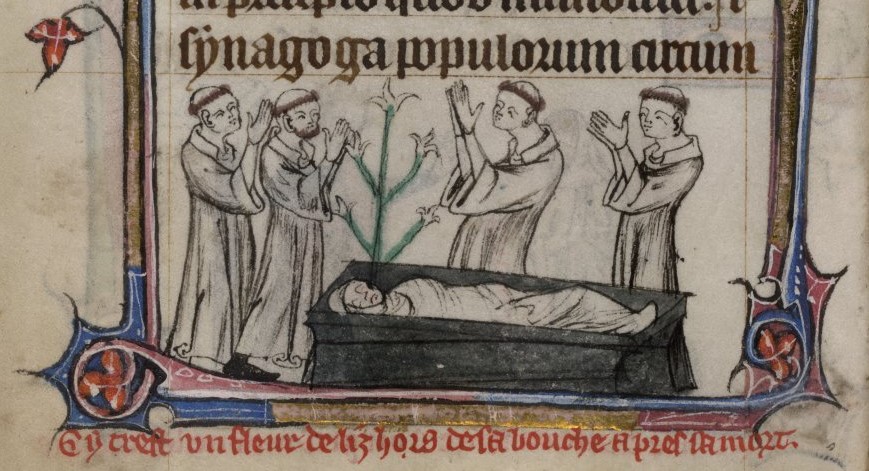Visual Odors
The Sense of Smell in Medieval European Art, c. 1200-c.1500
Contents: Odors and the Sense of Smell in Medieval Europe | The Collection | Avenues for Future Research | Tech
Odors and the Sense of Smell in Medieval Europe
In medieval Europe, a sweet scent was a sure way to recognize the holiness of a person, a place, or an object. Church ritual, particularly the mass, was perfumed with incense from the early centuries CE onward as a sign that the work of God was being done. Stories about saints refer to the miraculously pleasant scent of saints’ bodies after their deaths. This smell, the odor of sanctity, was proof of God’s favor. Artworks also refer to the role of the olfactory sense in medieval life. Scholars have only recently begun to acknowledge the role of the sense of smell in medieval Europe. Odors in art are particularly easy to overlook. For example, angels carrying censers often (perhaps even ‘usually’) form a part of images of Christ, Mary, and the saints as an extra marker of the holiness of the main figure. Angels with censers are ubiquitous in medieval art. However, until recently, they have attracted little attention from art historians. Yet the artists would not have bothered to include them if they were not meaningful. Flowers such as roses and lilies are also common in medieval art. The research that has been done on them rarely considers the effect of the flowers’ scents, despite the fact that written sources reveal that medieval people strongly associated flowers with their fragrance, sometimes more than with their appearance. Art with a less religious purpose also depicts odors, including images accompanying bestiary animals known for their odor and images that occur in a medical context. Medieval European art depicts invisible odors, both pleasant and foul, with signs of scent such as incense burners, flowers, or the reactions of figures to an invisible odor. Aroma forms as important a part of the narrative of medieval art as a reference to the odor of sanctity or to a plague-causing stench does in textual sources.
The Collection
The collection here currently includes only a small sampling of some of the ways that odor was represented in medieval art. Censing angels is just one example of the extremely common motif of angels swinging censers near a depiction of Christ. The bas-de-page illustrations in the Taymouth Hours (1, 2) give an example of the significance of flowers in medieval art and literature. The two illustrations tell the story of “The Monk who Only Knew the Ave Maria,” which is a tale from the Miracles of the Virgin, a collection of legends regarding miracles performed by the Virgin Mary. The monk in the story was so simple that the only prayer he could learn was the Ave Maria. The other monks looked down on him for his stupidity. When he died, a lily grew from his mouth, which proved his closeness with Mary. The lilies in the second illustration are symbolic of virginity in general and of Mary in particular. The sweet scent of the lily is found in nearly every textual description of the flower. Moreover, prayers were frequently described as rising like a sweet odor that pleases God, just as incense or a burnt offering might do. Therefore, the lilies in the monk’s mouth signify the pleasing odor of his simple prayers. Panther and Whale are two examples of bestiary figures that are strongly associated with their good-smelling breath. On the other hand, European medicine, based on theories from the ancient Greek and medieval Islamic worlds, taught that stench was a cause of disease from ancient times until the nineteenth century. The two images of St. Louis (1, 2) and the copy of Raphael’s work depict the stench of death, which is medically dangerous in the Raphael piece. Finally, Andreas Vesalius’s anatomical drawings of the brain (1, 2) depict changes in the scientific understanding of where the olfactory organs were located by the middle of the sixteenth century.
Avenues for Future Research
Olfaction and odor are as present in medieval art as they are in medieval texts. Odor might appear in many guises, depending on the requirements of the story and the limitations of the medium. However, there are a few common olfactory elements to look for in medieval art:
- figures with censers
- flowers, especially roses and lilies
- bestiary creatures, especially the panther, the whale, and the phoenix
- figures reacting to odor, especially of corpses
- figures pointing to their noses or smelling flowers (e.g., the early medieval English Fuller brooch)
Certain persons, places, or things might be considered odorous at all times, such as saints, flowers, fires or anything burning, the heavenly Jerusalem, heaven, and hell. Scientific depictions of odor and olfaction typically show people covering their noses in the presence of a sick or deceased person.
About the Author
Katelynn Robinson is the author of The Sense of Smell in the Middle Ages: A Source of Certainty (Routledge, 2020), which details the intellectual history of the sense of smell in central and late medieval Europe. She received her doctorate in History at the University of Missouri, Columbia in 2017 and continues to research the olfactory sense in medieval Europe. You can find her on Twitter at @SensusOlfactus Note on Images Every effort has been made to include only images that are in the public domain in the United States. If an image has been included that is under copyright, contact the author to have it removed.
Technical Credits - CollectionBuilder
This digital collection is built with CollectionBuilder, an open source tool for creating digital collection and exhibit websites that is developed by faculty librarians at the University of Idaho Library following the Lib-STATIC methodology.
This site is built using CollectionBuilder-gh which utilizes the static website generator Jekyll and GitHub Pages to build and host digital collections and exhibits.
